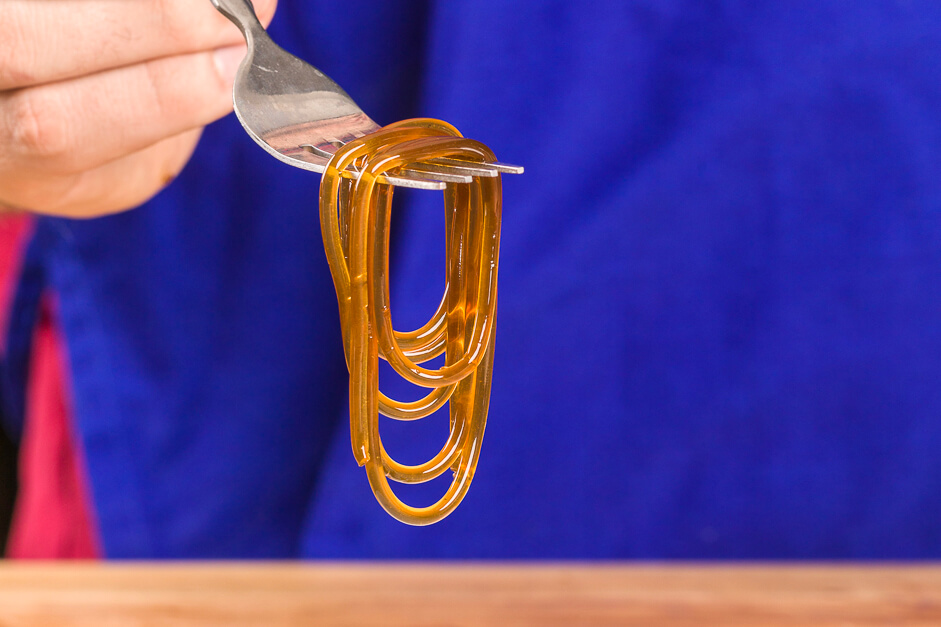The Struggle:
As with anything food related we strive to find different and new flavor combinations. Along with that we look for exciting ways to deliver familiar flavors. Popping spheres, delicate foams, and even noodles… Yes, noodles. We are not talking about making traditional noodles with new flavors. Literally making noodles out of anything. Sweet and complex carrot noodles as found in Rich Rosendale’s braised carrot dish or even our own ramen inspired deviled egg with savory mushroom noodles. These are new ways to elevate these common dishes to the next level. But what makes these noodles possible? How can you take an ingredient and turn it into a flexible and edible gel noodle?
“So how do gel noodles work?”
Spaghettification
Quickly, I want to say Spaghettification (google it) is not the culinary term for this technique. Although it sounds so good that we should adopt it. With many modernist culinary techniques we need to start with a flavorful liquid. Basically you need a liquid that is in your personal top 10 most delicious foods you’ve ever had. This will ensure the finished noodle will be delicious. A gel noodle is basically just that, it’s a gel shaped like a noodle. But the properties of the gel are very important to this process working. Gelling agents fall into a few categories we need to think about first – clear versus opaque, brittle versus elastic. These properties will decide a few things for us right away. If we need a clear noodle we must use a clear gelling agent. But if the liquid we are starting with is already opaque then there are more options. Next, we almost always want elastic noodles. A noodle looks best when we can wrap it around the tines of a fork without it falling apart. A brittle gel will not work in this situation as any pressure will cause the noodles to fall apart into irregular gel batons.
What ingredients work well with these types of noodles? Agar is a common ingredient for gel noodles. It works well because it creates a nice clear gel. Although it should raise a red flag because agar creates a brittle gel, which means it should not work. While agar is a brittle gel, here is where we learn about its synergistic qualities. When agar is mixed with locust bean gum it gains a new set of properties. The locust bean gum changes the agar gel from brittle to elastic. This allows for all those great stretchy qualities.
Other ingredients that work with gel noodles are Gellan Gum F and Gellan Gum Lt100. These two ingredients are different ends of the spectrum. Gellan gum F is clear and brittle while gellan gum LT100 is elastic and opaque. Once again, they have great synergistic qualities with each other. When they are mixed the clarity and elasticity come through. All while the brittle and opaque qualities are dampered.
Last thing about these noodles is the melting point. Many people have asked, “can’t I just use gelatin”? The answer to that is no, gelatin is a brittle gel. The second reason is that the gelatin noodle would only be able to withstand temperatures no warmer than body temperature. The noodles wouldn’t be noodles for long. Gellan gum and agar have high melting points. This means they can be added to warm and even hot dishes without reverting back to a liquid.
This all begs the question, how do you actually make the noodles. Well, I am glad you asked. Create a flavorful liquid and add the ingredients into it. We suggest using the ratios from our savory mushroom noodle recipe. Just replace the mushroom liquor with your flavorful liquid. Heat the liquid to a boil and keep it hot. Draw the liquid into the special rubber tubing. Plunge the tubes into an ice bath and allow them to set. Then simply extrude the noodles out when needed. These noodles are flexible and can even be coiled around a dish for a stunning appearance. Next time you want to impress anyone you can whip out this technique.



2 Comments.
Hello! I came across the Youtube video while trying to do some research to recreate a “jello” tube snack. The reason I say “jello” is because I noticed that the ingredients do not list gelatin, rather Locust Bean Gum and Xanthan Gum. This recipe and related video was helpful but I was wondering, if I were to incorporate both thickeners into my recipe, how would I do so? I believe there was a statement made that said both become activated when working together without a heating requirement? So, would I be able to blend these thickeners into a liquid either with a stick blender or vitamix at room temperature? Or does the liquid need to be warmed to a certain temperature. Beyond that, will the new gel become stiffer when stored in the fridge? Thanks in advance.
Blending Xanthan gum and locust bean gum will have a synergistic effect without heating. We are unsure how to make the jello type snack, would suggest starting at low ratios for both the locust bean gum and xanthan gum. They can be mixed into the liquid at the same time to create the gel.